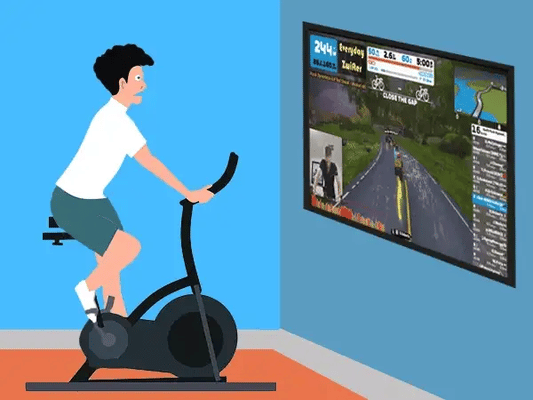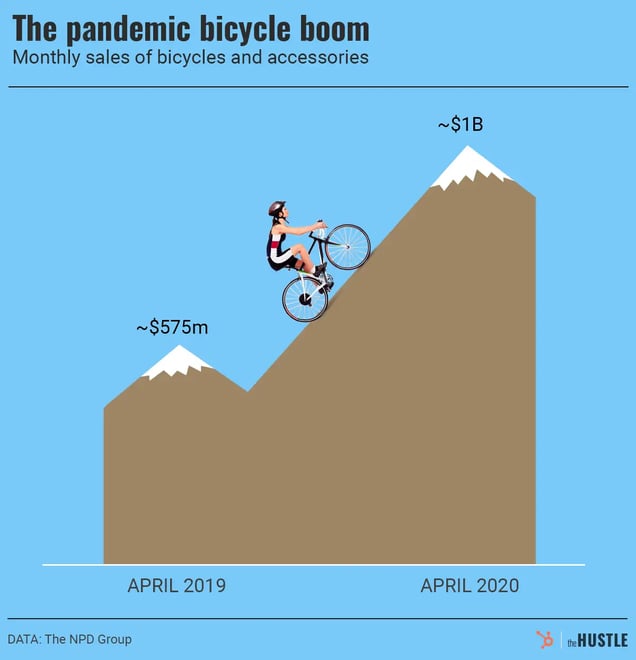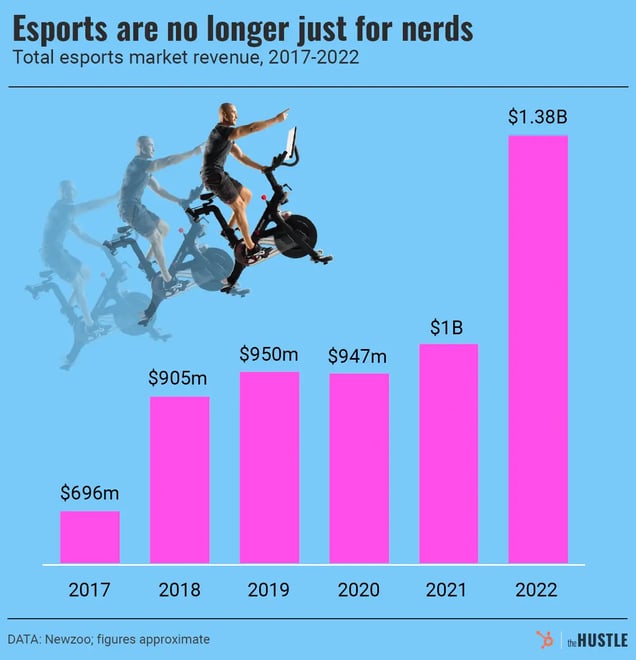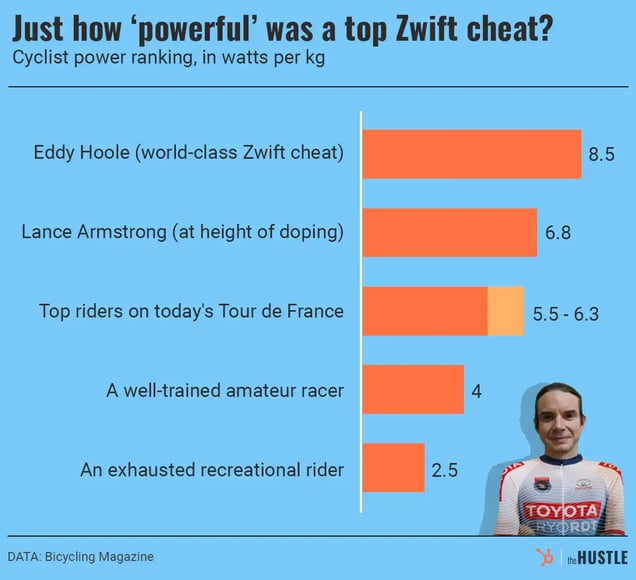Luciano Pollastri’s forehead slicked with sweat. His lungs shuddered as he climbed higher and higher into the sky.

His bike inched along, his calves searing at the unforgiving incline. As he watched a rider on an opposing team pull away from the peloton, he knew he couldn’t catch him, not now.
After Pollastri crossed the finish line, at 2.2k feet, he hopped off his bike, powered down his computer, and walked upstairs, ready for dinner.
Pollastri was riding in his basement on Zwift, a multiplayer virtual training program that lets cyclists train together at home. He’d been riding in the Zwift Racing League, the largest competition on the platform, against riders all over the world.

Luciano Pollastri became a Zwift devotee during the pandemic. (Via Luciano Pollastri)
Pollastri is a self-described data freak, so on the heels of his team’s loss that day in February 2022, he called up the stats of his competitors. He wanted to see what they’d done differently.
Right away, he realized a discrepancy. The power recording on Zwift, determined by dividing a rider’s wattage output by their self-reported weight, was way higher than it was on Strava, another cycling app that tracks rides simultaneously.
He was taken aback. It couldn’t be cheating. Could it?
“It would mean all this training is so useless,” he thought.
He decided to investigate further. He had no idea the magnitude of cheating his sleuthing would expose.
Fraud in a fictional universe
Launched in 2014, Zwift started as an app to help recreational cyclists stay fit through the winter.
Like Peloton, which offers a personal-training experience in the comfort of your home, Zwift users connect their stationary bikes to a fictional world called Watopia where riders’ avatars race around a screen and live statistics for speed and power are displayed on a leaderboard in real time.
In 2020, as covid set in, online fitness offerings exploded. Zwift’s business doubled.
But along with exponential growth has come an increase in cheating across all ranks of the game. Pollastri and other riders believe Zwift hasn’t done enough to stem it — and it’s starting to cost them.
“They’re taking a pretty hands-off approach to resolving cheating,” says Ray Maker, a triathlete and writer who covers Zwift for his blog DC Rainmaker. “Most of these aren’t bugs; they’re gaps in the design. And in some cases, I don’t think Zwift wants to fix them.”
During the pandemic, Pollastri was 10 months out of gastric bypass surgery, and down 150 pounds from a high of nearly 330. It had been decades since he’d been on a bike, but he was determined to keep the weight off and was intrigued by Zwift, becoming one of millions of people to buy in as sales of bike trainers spiked by 415%.
Pollastri began to ride two, three, four hours a day. Some nights, he lay awake, tormented at the thought of waking up in his old body. It was hard to talk about those things with anyone, even his wife. On Zwift, his pedals in constant motion, his headset hooked up to a Discord server, it was easy.
“I started believing in friendship, in humans, in solidarity again,” he said.

The Hustle
He got good, and fast. Two months in, he was recruited to ride for a competitive racing team. Like its IRL counterpart, esports racing offers riders sponsorships, prize money, and occasional glory. It attracts former Olympians, world champions, and elite riders whose schedules don’t allow them the freedom to train on actual grueling climbs in Europe.
Pollastri, 47, was a man obsessed.
“People took me for a crazy person,” he said. “It became even crazier when I started racing.” How, they wondered, could he spend so much time on a game?
But there was nothing virtual about the fact that they were a team, he thought. “A team of real people working so closely together that at one point it felt as if we shared the same heart rate,” he wrote later.
Zwift has had that effect on millions. As a private company, it doesn’t release user data, but:
- It reports 5m riders and 1m subscribers.
- Even in its community riding ranks, competitors hire performance coaches. They try to best each other by “Everesting,” climbing one hill over and over until they’ve reached the full 29k-feet height of Mount Everest.

The Hustle
The esports market is now valued at $1.72B, according to Fortune Business Insights, and expected to grow to $6.75B by 2030. Zwift has done a lot to establish e-cycling as a credible sport, creating a racing division divided into five categories by ability.
Since 2018, the platform has run world championships in partnership with UCI, the governing body of IRL cycling, and from its pro racers right on down Zwift riders are fiercely competitive, analyzing reams of public data to harness every scrap of power they can to make the virtual podium.
By many, Zwift is seen as an equalizer — an affordable way into a prohibitively expensive sport. It’s also a way to draw a younger audience to cycling.
And as its user base grows, so too does its place in the modern sports landscape. E-racing is set to be a demo sport at the Paris Olympics next year, and enthusiasts are gunning for a permanent spot in 2028.
#FreeLuciano
The day after the February 2022 race, Pollastri set up his video equipment. He wanted to record himself trying to show how the other riders might have cheated.
He was sure the cheat wouldn’t work, and he thought the fail would make for a fun blog post. It seemed too simple: riders toggling their weight mid-race to falsely inflate their speed and power recording, and cover the race course faster.
Live on camera, he discovered that the cheat worked.

Riders compete on a course in Zwift’s Watopia metaverse. (Zwift)
Right away, he reported it to the company, which said they didn’t monitor possible cheating outside of their top pro division (Pollastri was two rungs below, in the second community division).
His fellow racers’ data was public, so he began to compare it, rider by rider, and found that roughly 10% appeared to be cheating, using that method alone.
He decided to publish what he’d found. The post racked up 800k visits in a day.
It wasn’t knowing about the cheat that made someone a cheater, he reasoned. It was using it. The platform disagreed. Zwift issued a shadowban, allowing Pollastri to still ride — but no one could see his results.
That meant Pollastri couldn’t ride for his team, and when word got out, backlash was swift.
Committed Zwifters created a hashtag, #freeluciano, and began to post it everywhere they could. Riders canceled their subscriptions. In the livestream of the world championship qualifying events, viewers commented, “#freeluciano, #freeluciano, #freeluciano.”

A Zwift team celebrates a victory at the Olympic Esports Week. (Yong Teck Lim/Getty Images)
Eventually the company’s CEO reversed the ban, issued an apology, and promised a reward for anyone who found loopholes, or bugs, as a way to better crack down on cheaters.
But the moment he published, Pollastri became a magnet for others who’d also found ways around the platform’s code or holes in the verification process.
Riders from all over the world wrote in, some with cheats so technical Pollastri didn’t understand them. Before long, he’d amassed more than 50 new ways to cheat:
- Zwifters sent videos of themselves not pedaling but still producing high levels of watts.
- Some used hair dryers on their sensors to register more power, or paint rollers to exert more pressure on their flywheels.
- Elite riders learned the serial codes of batches of smart trainers that overreported a rider’s power, and sought them out on the used market. Anything to add 10 or 20 watts to their overall power.
Pollastri’s joy was shattered.
“If I could go back in time, I would rather not have any of this happen,” he told The Hustle. “I felt so proud, so connected with other people.”
Cheats and punishment
Where there is glory, there are humans who will take shortcuts to get it.
Back in ancient Greece, statues weren’t constructed to celebrate athletes: They were built to shame them into not cheating.
Cheating is just as endemic to cycling, too. The first-ever winner of the Tour de France, Maurice Garin, was stripped of his title when he won the second race in 1904. Allegations flew of Garin taking the train to speed himself along various stages of the course. Another rider that year purportedly hitched a ride with a motorcycle, pulling a revolver on the competitor who spotted his misdeed.
On Zwift, no cyclists are pulling revolvers. But the overlay of tech and sport does mean more loopholes — and more ways to exploit them.
“In some ways, drugs are easier to test for,” says Maker, the triathlete and blogger who covers Zwift. “Technical cheating is much more complicated to prove.”
For years, Zwift has banned pro racers caught in contravention of its rules, including the winner of the inaugural British Cycling eRacing national championships and a nationally ranked Israeli triathlete.
In February 2022, software developer and elite Zwifter Eddy Hoole posted superhuman results during a qualifying race for the UCI eSports World Championships.
- Hoole’s data showed him riding at an average power output of 8.5 watts per kilogram for a 4:16 climb.
- For contrast, Lance Armstrong at his best could maintain a 6.8 watts per kilogram power ratio. (Hoole got a six-month ban.)

The Hustle
What the community wants, Maker says, is a crackdown that goes further than the pro racing ranks.
“The community wants them to prosecute those cases that are not rock solid. That’s much tougher to do.”
It’s also not a priority for the company, which is busy trying to compete with Peloton’s $3.58B in revenue with an expansion into hard goods and establishing itself as a racing platform by hosting in-person events and offering more prize money to its top riders.
More than a shadowban
Still, ignoring a vocal minority of hardcore users is starting to have consequences.
Earlier this year, a group of Zwift employees, including the chair of its esports commission and members of the performance verification agency funded by Zwift, defected to start their own platform. IndieVelo, a platform dedicated specifically to e-racing, is focused on authentic performance and includes several verification checks that Zwift can’t, without rewriting their entire codebase from the ground up.
Zwift experienced another high-profile loss in September. UCI announced that it was dropping Zwift, which had created the esports world championship event, as the platform of choice for the next three years.

A cyclist stares at a Zwift simulation on a laptop. (Bernd Thissen/Getty Images)
Zwift’s director of external communications, Chris Snook, acknowledges that the company monitors its pro racing much more strictly than its community rides.
“We want to create something that’s appealing to young people that want to watch, and that’s a legitimate and credible sport at the very highest level. We’re trying to create a platform for new stars.”
Monitoring community racing is difficult for the company with so many more people participating.
“The primary focus for us on that side of things is just to make sure people have fun,” he says.
After Hoole’s insane results made international news, all the talking Pollastri had done about cheating looked to Zwifters less like raising awareness and more like stirring controversy.
New rules sprouted up on the forums he frequented: Any discussion of cheating was forbidden. Before long, he was kicked out. Riders who’d once been friends went quiet. He received death threats at home.
Ultimately, he decided, it wasn’t worth it.
In March, once he wrapped his season with his team, Pollastri left the platform and joined IndieVelo.
He became a founding member of FERA, the Fair E-Racing Alliance, where he works with 25 other volunteers to assess suspected cheats across ~60 online cycling teams. The list of ways to cheat on Zwift he amassed? It’s now up to 127.
“Zwift has created this whole environment based on the idea of ‘real people are competing, let’s do sports in a fair way,’” he says. “They say, ‘Let’s have a worldwide competition!’ They don’t mention that they can’t guarantee fairness in competition.”
He tries not to think about the people doing harm to the sport he loves. What endures for him is the community spirit that carried him through his darkest times.
“We say social networks distance people,” he says. “Zwift brought people closer together.”
